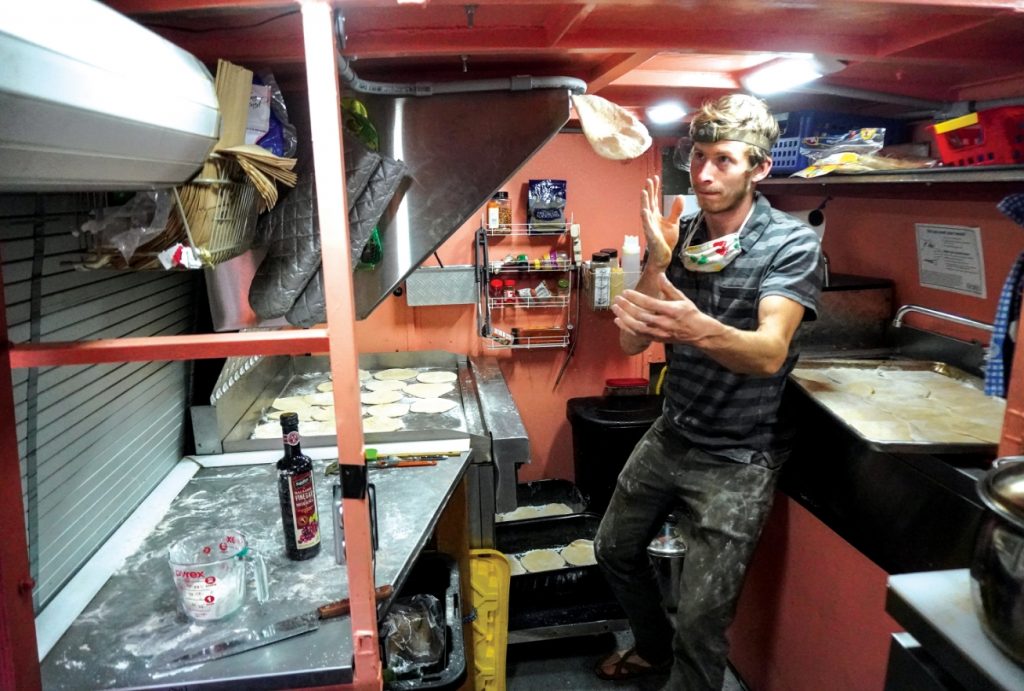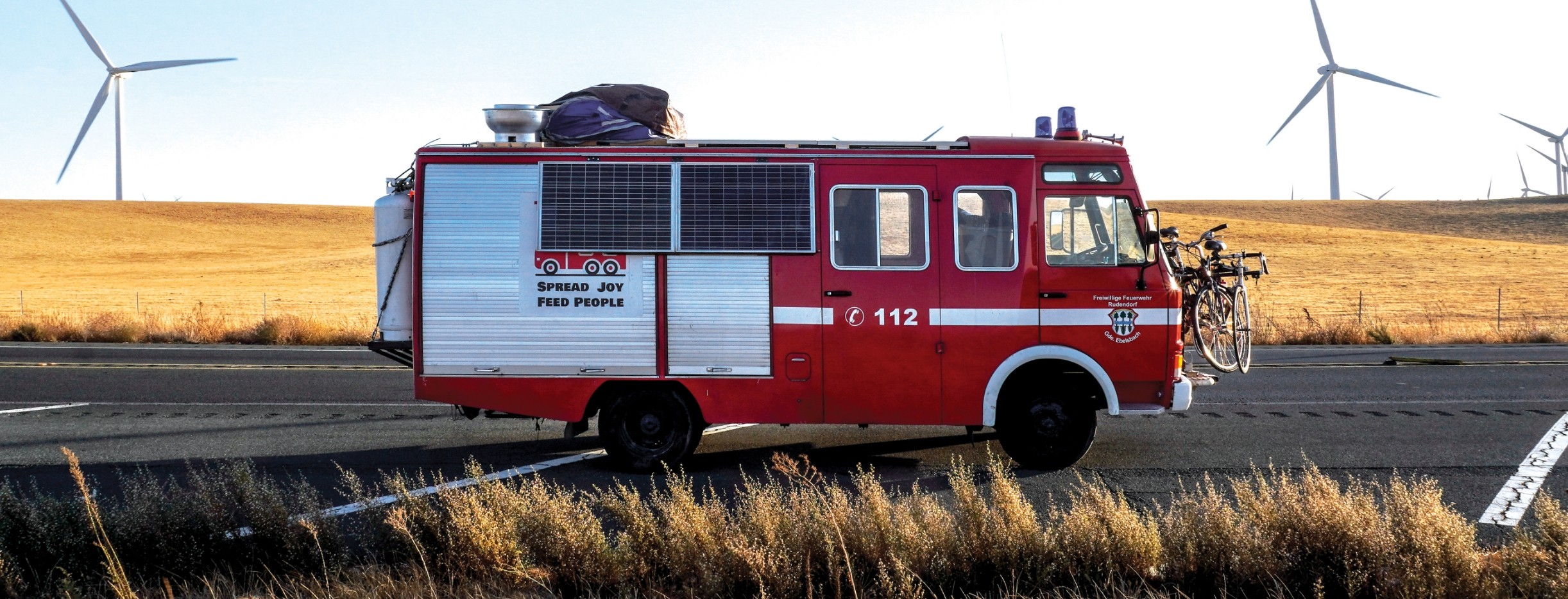Spread Joy, Feed People
A couple of years into his first post-Harvey Mudd college job, Tyler Smallwood ’17 started to feel restless. Though he enjoyed the work—research and design engineering at an aerospace startup in Seattle—he was getting tired of sitting at a desk. He’d saved some money and had a desire to travel, so he quit the job and set off to find adventure. He was in Chile in March 2020 when he had to return home quickly as the COVID pandemic began. Choosing to stay with an aunt and uncle in California, his travels were on hold, but his adventure had just begun.
Safe, insulated from the worst of pandemic and with plenty of time to kill, Smallwood was feeling increasingly like he should be doing something to help people more directly affected by the crisis. “I felt like my life was just so cushy living with my aunt and uncle in California,” he says. “We were sitting around at home and not able to do much, but you aren’t really feeling repercussions of like the world flipping upside down.”

Tyler Smallwood ’17 and his partner served free meals to more than 1,000 people from his converted fire truck.
To stay busy, exercise his engineering muscles and earn some money during the pandemic, Smallwood and a friend began browsing Craigslist for vehicles that they could convert into other things for resale. When Smallwood found a 40-year-old German firetruck, the idea to convert it into a food truck was born.
“We came across this fire truck and determined that buying it could be a little risky, but I always kind of wanted to run a food truck,” he says. After many conversations with the truck’s owner, Smallwood bought the truck and moved to Bend, Oregon, where his parents owned some property. “I hunkered down and built myself a little house and converted the fire truck into a food truck which was quite the endeavor.
“I’ve always loved building and designing things, and that’s sort of where engineering came about when I went to Mudd,” he says. “I definitely get a little distracted when I’m sitting on a computer all day, so it was pretty fun to just kind of pour myself into these hands-on projects that definitely dealt with engineering but weren’t like building spaceships or anything.”
Once the food truck, christened Tetrafunk, was ready, Smallwood hit the road, joined by his friend Eva, who had recently quit her job as a barista in Seattle and was eager to help. “We started in Oregon, in Bend, and drove over the Cascades to a bunch of the towns that had been hit by the wildfires in summer 2020. We basically lived out of the truck and her car and just drove around serving food to people.
“It was just kind of amazing how easy it was to find opportunities,” he says. “For example, we were in a parking lot of a food outlet in Eugene, Oregon, and some random person came along who was interested in the fire truck. We got to talking, and we ended up serving food with him in one of the fire relief centers. We had zero plans. Pretty much we’d just show up in a new city and find areas where unhoused people were staying, or we’d find someone who could tell us where there was a need, or we’d show up at a homeless shelter and serve a bunch of food. It was a really cool experience. Totally unlike anything I’ve ever done before that. It was a wildly different way to travel, but super rewarding.”
Menu planning was also spontaneous. “Usually, we’d go to a local store and see what was available, look up a recipe and multiply it. Whatever we thought would be fun. We tried to do mostly vegetarian, which was interesting. Some of the crowds we served were not as into that. And it also depended on what we served. Everyone likes black bean enchiladas, but we served black bean burgers one day and some people liked it but others not so much.”
In addition to learning what food was popular, the pair also had to learn how to cook a lot of it in the small space, managing time and available electricity and storage. “Mostly it was a challenge trying to figure out how to serve that many people,” he says. Tetrafunk is equipped with a large griddle, a large oven and a two-burner stove to make rice or pasta. Solar panels on top of the truck provide power. “Sometimes Eva would be cooking in the back of the truck while I was driving to the next destination,” Smallwood says.
At the end of 2020, Smallwood moved back to Bend, and Eva moved back to Seattle. Smallwood estimates they served more than 1,000 meals using donations from family and friends to fund the operation.
Upon his return to Bend, Smallwood connected with a local group called Rogue Knights which organizes food services to meet the needs of local people. “They funded me once a week to serve as much food as I could in Bend, where there’s a pretty significant unhoused population. If I go out, I can usually find about 80 people who want a meal,” he says.
Smallwood isn’t sure what he’ll do next. “I’m still figuring it out,” he says. He recently earned his substitute teaching license. “I have been teaching quite a bit,” he says. “The Harvey Mudd education has been quite useful in its breadth. I still feel like I have a good grasp of chem, bio, math, physics, etc.”
As for the food truck, Smallwood and his partner, Nikki Holzman, have begun to use Tetrafunk as a catering service for events to help raise money for the nonprofit (free meal) arm. “Each catered meal will also donate a meal to someone in need,” he says.
Whatever’s next for Smallwood, it will likely include travel (he recently completed a biking trip in Baja California) and more hands-on adventure. For now, perhaps the Tetrafunk motto sums it up best: Spread joy, feed people.
West African Peanut Stew
Tetrafunk Edition
(Serves 50)
- 1/3 cup olive oil
- 2 heads garlic
- 1/2 cup grated fresh ginger
- 10 onions
- 10 lbs sweet potatoes
- 3 tbsp cumin
- 48 oz tomato paste
- 4 cups peanut butter
- 3 gallons water
- 2 jars Better than Bouillon
- 5 cups red quinoa
- 5 cups chopped kale
- 2 bunches cilantro
- 3 cups chopped peanuts
- Peel and grate the ginger, mince the garlic, and
dice the onion. Sauté the onion, ginger and garlic
in a gigantic pot with the olive oil until it smells
delicious. - Dice the sweet potato into 1/2-inch cubes. Add
the sweet potato cubes, cumin and red pepper to
the pot and continue to sauté until sweet potato
has softened a little. - Add the tomato paste, peanut butter, water and
bouillon to pot. Stir until the peanut butter and
tomato paste have mostly dissolved into the
broth. Place a lid on the pot and turn the heat up
to high. Allow the stew to come up to a boil. Add
dry quinoa. - Once it reaches a boil, turn the heat down
to medium-low and allow it to simmer for 30
minutes, or until the sweet potatoes are very soft
and the quinoa is cooked. - Turn off the heat and add the kale. Add salt and
pepper as desired. Garnish with cilantro and
chopped peanuts. Enjoy!
